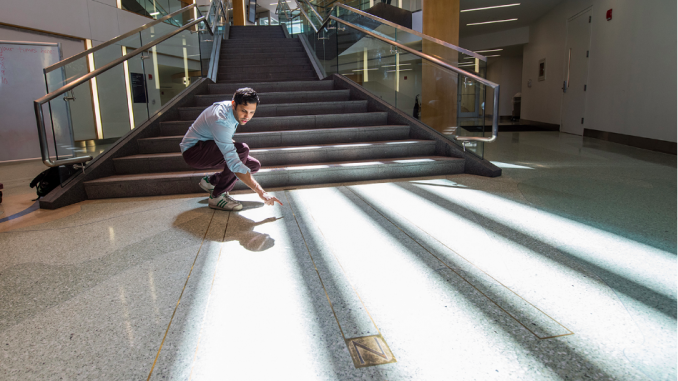
With the recent welcoming of Spring, and the sun’s enjoyable warmth that came along with it—it seems like the days of puffy winter coats and the sun setting at 3 p.m. was ages ago.
Students keeping their head down while they somberly trudge from building to building to escape the wintery cold is a thing of the past. Students now strut around campus wearing t-shirts and capris and bask in the sunlight while they throw around a Frisbee on the Old Main quad.
As part of the SUNY New Paltz eight-part Evolutionary Studies Seminar Series, a lecture entitled “Solar Events and the Human Experience: Why the Sunlight in Wooster Hall Matters” helped to address why sunlight is important to the human experience. The evolutionary studies department, the evolutionary studies club and the department of anthropology collaborated on this event.
From 6 p.m. to 7:30 p.m., students, faculty, staff and community members filled the Coykendall Auditorium for the discussion about the powers of solstices, equinoxes and the movements of the Sun to inspire human beings.
Prior to this lecture, at 12:45 p.m., those interested in observing the Spring Equinox were able to admire the magnificent solar noon sunlight passing through the carefully designed windows and aligning with patterns at the foot of the stairwell.
The lecture was given by three speakers, each bringing their own specialized perspective to the table.
Randy Croxton, the chief architect of the Wooster Hall remodel and president of Croxton Collaborative Architects, gave a detailed account on the process of designing Wooster Hall and how he brought nature into his architecture.
Croxton addressed the historical and cultural shift in humans connecting with and understanding the “light, Earth and moving under the Sun,” Croxton said. “Humans have not been connected to that for a very, very long time.”
The Wooster Hall that we know now is an inverse relationship to “Wooster 1,” as Croxton put it, earning some chuckles from the audience. In 2016, Wooster Hall was transformed from a “75,000 square foot obsolete 1967 Brutalist concrete structure” into the “state-of-the-art” academic facility Wooster is today. “There was no connection to the outside, other than knowing the number of the door,” Croxton said.
In designing Wooster Hall, Croxton worked diligently to find a way to tame natural light, foster soft light, use small apertures and create lots of places for photons to bounce off of to create lighted canopies overhead. The beams of light greeting you as you walk into the bottom floor entryway of Wooster is meant to “give you a sense of the traverse of the Sun, the time of day and begin to bring you back to natural systems,” Croxton said.
Croxton shot a panorama of the Gunks, which is now a mural on Wooster’s second floor that wraps all the way around to the lounge. The floor of the main entry hall is a USGS map oriented to the campus.
“The main entry hall is also trying to do something that has been lost, that is the ability to observe and see your environment, to be in control of your environment, to feel that you know where you’re going and where things are located,” Croxton said.
Raj Pandya, director of the John R. Kirk Planetarium and lecturer of physics and astronomy, honed in on how math and physics work towards the solar events in Wooster Hall. He quizzed the audience on what causes the Earth’s seasons, and affirmed that the solstices, equinoxes and solar movements are dependent on Earth’s tilt—all shaping the human experience.
Yet, Pandya’s explanation on why the sunlight in Wooster Hall is important to the human experience seemed to be bogged down by the densely scientific presentation on solstices and equinoxes.
Joseph Diamond, associate professor of anthropology, approached the solar experiences through a historical and cross-cultural perspective. Diamond extensively discussed the anthropological significance of the famous prehistoric monument “Stonehenge”—which Croxton aimed to emulate in the design of Wooster.
It was the start of the precursors for people to actually pay attention to the alignment of the Sun, the alignment of the Moon and different points of the year following the stars. Stonehenge was therefore inspired by these astrological paradigms.
“People around the world are really integrating their lifestyles with the Sun, the Moon and also with the seasons,” Diamond said. “In terms of how we see the Sun and the Moon there is that idea of light and dark, the idea of people being alive and the way people dying being taken into the darkness and being reborn.”

